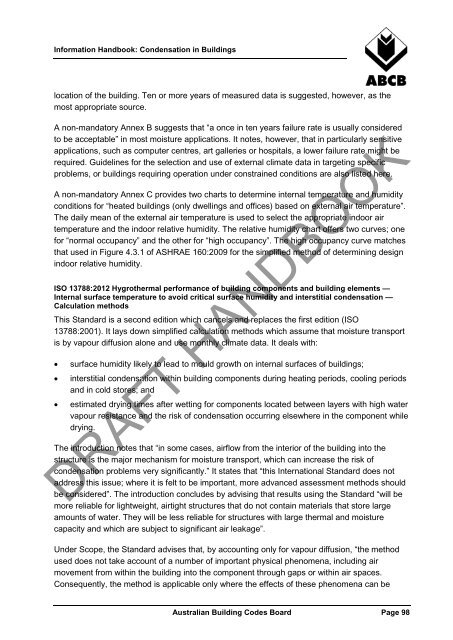Condensation in Buildings - Australian Building Codes Board
Condensation in Buildings - Australian Building Codes Board
Condensation in Buildings - Australian Building Codes Board
Create successful ePaper yourself
Turn your PDF publications into a flip-book with our unique Google optimized e-Paper software.
Information Handbook: <strong>Condensation</strong> <strong>in</strong> Build<strong>in</strong>gs<br />
location of the build<strong>in</strong>g. Ten or more years of measured data is suggested, however, as the<br />
most appropriate source.<br />
A non-mandatory Annex B suggests that “a once <strong>in</strong> ten years failure rate is usually considered<br />
to be acceptable” <strong>in</strong> most moisture applications. It notes, however, that <strong>in</strong> particularly sensitive<br />
applications, such as computer centres, art galleries or hospitals, a lower failure rate might be<br />
required. Guidel<strong>in</strong>es for the selection and use of external climate data <strong>in</strong> target<strong>in</strong>g specific<br />
problems, or build<strong>in</strong>gs requir<strong>in</strong>g operation under constra<strong>in</strong>ed conditions are also listed here.<br />
A non-mandatory Annex C provides two charts to determ<strong>in</strong>e <strong>in</strong>ternal temperature and humidity<br />
conditions for “heated build<strong>in</strong>gs (only dwell<strong>in</strong>gs and offices) based on external air temperature”.<br />
The daily mean of the external air temperature is used to select the appropriate <strong>in</strong>door air<br />
temperature and the <strong>in</strong>door relative humidity. The relative humidity chart offers two curves; one<br />
for “normal occupancy” and the other for “high occupancy”. The high occupancy curve matches<br />
that used <strong>in</strong> Figure 4.3.1 of ASHRAE 160:2009 for the simplified method of determ<strong>in</strong><strong>in</strong>g design<br />
<strong>in</strong>door relative humidity.<br />
ISO 13788:2012 Hygrothermal performance of build<strong>in</strong>g components and build<strong>in</strong>g elements —<br />
Internal surface temperature to avoid critical surface humidity and <strong>in</strong>terstitial condensation —<br />
Calculation methods<br />
This Standard is a second edition which cancels and replaces the first edition (ISO<br />
13788:2001). It lays down simplified calculation methods which assume that moisture transport<br />
is by vapour diffusion alone and use monthly climate data. It deals with:<br />
• surface humidity likely to lead to mould growth on <strong>in</strong>ternal surfaces of build<strong>in</strong>gs;<br />
• <strong>in</strong>terstitial condensation with<strong>in</strong> build<strong>in</strong>g components dur<strong>in</strong>g heat<strong>in</strong>g periods, cool<strong>in</strong>g periods<br />
and <strong>in</strong> cold stores; and<br />
• estimated dry<strong>in</strong>g times after wett<strong>in</strong>g for components located between layers with high water<br />
vapour resistance and the risk of condensation occurr<strong>in</strong>g elsewhere <strong>in</strong> the component while<br />
dry<strong>in</strong>g.<br />
The <strong>in</strong>troduction notes that “<strong>in</strong> some cases, airflow from the <strong>in</strong>terior of the build<strong>in</strong>g <strong>in</strong>to the<br />
structure is the major mechanism for moisture transport, which can <strong>in</strong>crease the risk of<br />
condensation problems very significantly.” It states that “this International Standard does not<br />
address this issue; where it is felt to be important, more advanced assessment methods should<br />
be considered”. The <strong>in</strong>troduction concludes by advis<strong>in</strong>g that results us<strong>in</strong>g the Standard “will be<br />
more reliable for lightweight, airtight structures that do not conta<strong>in</strong> materials that store large<br />
amounts of water. They will be less reliable for structures with large thermal and moisture<br />
capacity and which are subject to significant air leakage”.<br />
DRAFT HANDBOOK<br />
Under Scope, the Standard advises that, by account<strong>in</strong>g only for vapour diffusion, “the method<br />
used does not take account of a number of important physical phenomena, <strong>in</strong>clud<strong>in</strong>g air<br />
movement from with<strong>in</strong> the build<strong>in</strong>g <strong>in</strong>to the component through gaps or with<strong>in</strong> air spaces.<br />
Consequently, the method is applicable only where the effects of these phenomena can be<br />
<strong>Australian</strong> Build<strong>in</strong>g <strong>Codes</strong> <strong>Board</strong> Page 98
















